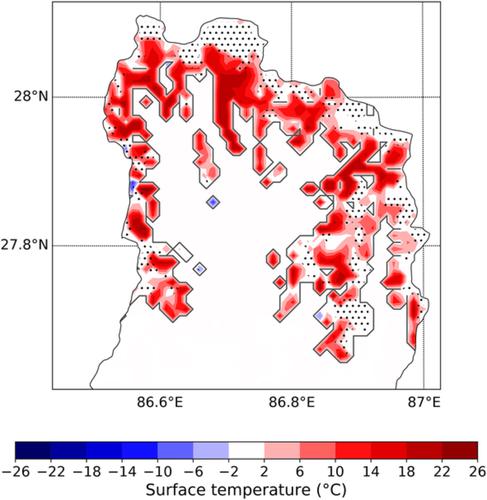当前位置:
X-MOL 学术
›
Atmos. Sci. Lett.
›
论文详情
Our official English website, www.x-mol.net, welcomes your feedback! (Note: you will need to create a separate account there.)
Meteorological impacts of a novel debris‐covered glacier category in a regional climate model across a Himalayan catchment
Atmospheric Science Letters ( IF 3 ) Pub Date : 2020-11-22 , DOI: 10.1002/asl.1018 Emily R. Potter 1, 2 , Andrew Orr 1 , Ian C. Willis 2 , Daniel Bannister 1 , Patrick Wagnon 3
Atmospheric Science Letters ( IF 3 ) Pub Date : 2020-11-22 , DOI: 10.1002/asl.1018 Emily R. Potter 1, 2 , Andrew Orr 1 , Ian C. Willis 2 , Daniel Bannister 1 , Patrick Wagnon 3
Affiliation

|
Many of the glaciers in the Nepalese Himalaya are partially covered in a layer of loose rock known as debris cover. In the Dudh Koshi River Basin, Nepal, approximately 25% of glaciers are debris‐covered. Debris‐covered glaciers have been shown to have a substantial impact on near‐surface meteorological variables and the surface energy balance, in comparison to clean‐ice glaciers. The Weather Research and Forecasting (WRF) model is often used for high‐resolution weather and climate modelling, however representation of debris‐covered glaciers is not included in the standard land cover and soil categories. Here we include a simple representation of thick debris‐covered glaciers in the WRF model, and investigate the impact on the near‐surface atmosphere over the Dudh Koshi River Basin for July 2013. Inclusion of this new category is found to improve the model representation of near‐surface temperature and relative humidity, in comparison with a simulation using the default category of clean‐ice glaciers, when compared to observations. The addition of the new debris‐cover category in the model warms the near‐surface air over the debris‐covered portion of the glacier, and the wind continues further up the valley, compared to the simulation using clean‐ice. This has consequent effects on water vapour and column‐integrated total water path, over both the portions of the glacier with and without debris cover. Correctly simulating meteorological variables such as these is vital for accurate precipitation forecasts over glacierized regions, and therefore estimating future glacier melt and river runoff in the Himalaya. These results highlight the need for debris cover to be included in high‐resolution regional climate models over debris‐covered glaciers.
中文翻译:

喜马拉雅流域区域气候模型中新发现的冰川覆盖的冰川类别的气象影响
尼泊尔喜马拉雅山的许多冰川部分覆盖着一层松散的岩石,称为碎片覆盖层。在尼泊尔的Dudh Koshi河流域,大约25%的冰川被碎屑覆盖。与纯冰冰川相比,已发现碎屑覆盖的冰川对近地表气象变量和表面能平衡具有重大影响。天气研究和预报(WRF)模型通常用于高分辨率的天气和气候建模,但是标准的土地覆盖和土壤类别中不包括碎屑覆盖的冰川。在这里,我们在WRF模型中包括了厚厚的被碎屑覆盖的冰川的简单表示,并研究了2013年7月对Dudh Koshi河流域近地表大气的影响。与使用观测值相比,与使用默认类别的无冰冰川的模拟相比,发现包含这一新类别可以改善近地表温度和相对湿度的模型表示。与使用纯冰进行的模拟相比,模型中增加了新的碎屑覆盖类别,从而使冰川覆盖的碎屑部分上的近地面空气变暖,并且风向谷底继续延伸。因此,这对有和没有碎屑覆盖层的冰川两部分的水蒸气和与塔集成的总水路径都有影响。正确模拟诸如此类的气象变量对于准确预测冰川地区的降水至关重要,因此可以估算喜马拉雅山未来的冰川融化和河流径流。
更新日期:2020-11-22
中文翻译:

喜马拉雅流域区域气候模型中新发现的冰川覆盖的冰川类别的气象影响
尼泊尔喜马拉雅山的许多冰川部分覆盖着一层松散的岩石,称为碎片覆盖层。在尼泊尔的Dudh Koshi河流域,大约25%的冰川被碎屑覆盖。与纯冰冰川相比,已发现碎屑覆盖的冰川对近地表气象变量和表面能平衡具有重大影响。天气研究和预报(WRF)模型通常用于高分辨率的天气和气候建模,但是标准的土地覆盖和土壤类别中不包括碎屑覆盖的冰川。在这里,我们在WRF模型中包括了厚厚的被碎屑覆盖的冰川的简单表示,并研究了2013年7月对Dudh Koshi河流域近地表大气的影响。与使用观测值相比,与使用默认类别的无冰冰川的模拟相比,发现包含这一新类别可以改善近地表温度和相对湿度的模型表示。与使用纯冰进行的模拟相比,模型中增加了新的碎屑覆盖类别,从而使冰川覆盖的碎屑部分上的近地面空气变暖,并且风向谷底继续延伸。因此,这对有和没有碎屑覆盖层的冰川两部分的水蒸气和与塔集成的总水路径都有影响。正确模拟诸如此类的气象变量对于准确预测冰川地区的降水至关重要,因此可以估算喜马拉雅山未来的冰川融化和河流径流。


























 京公网安备 11010802027423号
京公网安备 11010802027423号